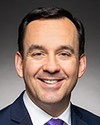Perhaps I could start with the answer. Thanks for the question.
I think Andrew's comments in the presentation are clear around some of the key impediments. The Indian Act is the major impediment to business on reserve, unquestionably. I think that where we have been successful either by sectoral or self-government agreements is we have gotten people out of the Indian Act through things like self-government agreements themselves, or through things like the First Nations Fiscal Management Act or the First Nations Land Management Act. Basically, these are things that are allowing people to remove the constraints of the Indian Act from how they do business. All these things have shown a lot of success, and so I think increasing the use of those regimes as well as finding other alternatives to the Indian Act is a good thing.
There are also provisions within the Indian Act that are kind of paternalistic or anachronistic, like the treatment of Indian moneys. This is something that deserves some attention and needs to be examined in a more fulsome way. The National Aboriginal Economic Development Board provided some recommendations to the minister recently around the need to examine the provisions around Indian moneys.
We mentioned developmental lending and access to capital, and I think in terms of business development the network of AFIs has been very useful to building a class of entrepreneurs across Canada. In terms of the value for money, that regime works very well indeed. The other thing is, on a comment made around access to capital, it's not only access to capital, but rather the cost of capital as well.
Part of the challenge is around not having secure, let's say, ownership or tenure on reserve; for instance, you can't securitize it. Lending certainly happens on reserve, but a lot of the lending is secured only by people's income. So, you're paying more for the money than you would be if you were able to borrow or take out a mortgage against your house, which is kind of difficult. So, it's also the cost of capital, not just access to capital.
Another thing is infrastructure spending and how we support infrastructure on reserve, which is critical to economic development. The Senate committee is looking at this issue itself, so there might be some crosswalks to be made between what their deliberations are and your thinking around some of the issues around access to capital.
Financial management literacy is the other important element as well. We have something called the First Nations Financial Management Board in addition to some of the stuff that Brad spoke about. The Financial Management Board is working with communities across Canada to increase their capacity around financial management both with respect to their financial management processes and systems and with respect to their performance. That has been exceedingly successful, and it's also building on that success particularly. I noticed in your list of potential witnesses that you have representatives from the First Nations Fiscal Management Act regime, so the the First Nations Tax Commission, the First Nations Finance Authority, and the First Nations Financial Management Board. Those institutions all work together in a way that is extremely useful for first nations in terms of having first nations governments having access to capital in a way that would not have been possible without that regime.
I will close by saying that those are some of the key issues around access to capital.





